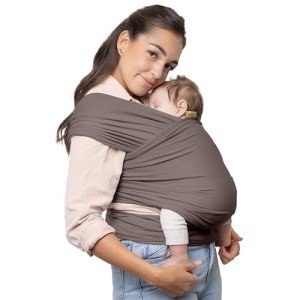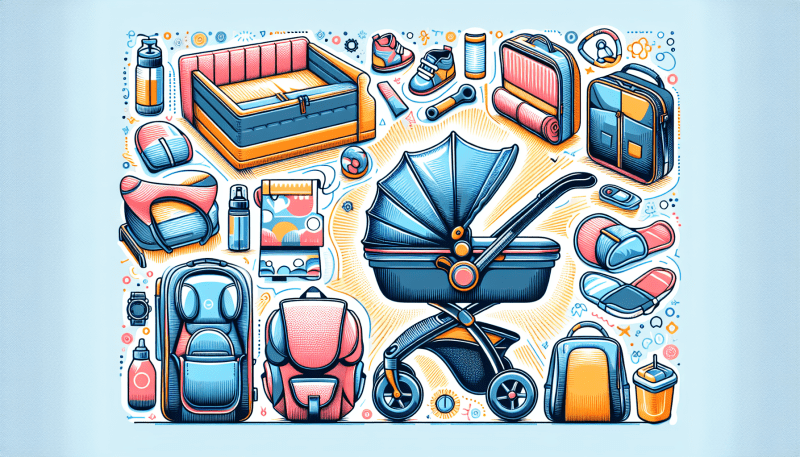You've got a new baby and carrier but no clue how to use it? Don't worry! We'll guide you through the steps, ensure your newborn's safety, and make your life easier.
This article teaches you how to position, carry, and maintain your baby carrier properly. You'll also discover common pitfalls to avoid.
So strap in, and let's make parenting a little less daunting together.
Key Takeaways
- It is understanding the different types of baby carriers available on the market and their specific features and benefits.
- We prioritize safety by following safety guidelines for using a baby carrier, including correct positioning and monitoring the baby's breathing.
- Step-by-step instructions for putting on a baby carrier, including choosing the suitable page, positioning the newborn for comfort and safety, and securing the straps properly.
- Tips for positioning and comfortably carrying a newborn in a baby carrier include keeping the baby's airways open, ensuring newborn comfort, and checking carrier accessories and pads.
Understanding the Different Types of Baby Carriers
You'll find a variety of baby carriers on the market, each designed with specific features and benefits to suit different needs and preferences. Carrier Material Choices range from natural fibers like cotton and linen to synthetic blends with durability and easy maintenance. They can also be soft-structured, wraps, slings, or meh dai, each providing unique comfort and support for you and your newborn.
Cultural variations in carrying also influence the design of baby carriers. For instance, African cultures often use wraps for back carrying, while Asian cultures prefer the Mei Tai style. Understanding these variations will provide you with a wider range of options and a deeper appreciation of the diversity in child-rearing practices worldwide.
Boba Stretchy Baby Wrap Carrier
The perfect choice for keeping your little one close and secure
Product information
$44.99 $39.98
Product Review Score
4.9 out of 5 stars
41 reviewsProduct links
Safety Guidelines for Using a Baby Carrier
As you venture into the practical world of baby carriers, it's crucial to prioritize safety above all else. You're not just strapping on a carrier; you're handling precious cargo.
Let's delve into essential safety guidelines, such as correct carrier positioning and monitoring your baby's breathing.
Correct Carrier Positioning
Ensuring the carrier is positioned correctly is essential for your baby's safety and comfort. Carrier Ergonomics and Infant Comfort are closely linked. The correct carrier positioning can drastically improve your infant's experience. Here's what you need to keep in mind:
Carrier Position:
- Facing In: It's ideal for newborns up to 5 months. They'll feel secure hearing your heartbeat.
- Facing Out: Suitable for babies over five months. They'll enjoy the view.
Carrier Ergonomics:
- Seat Width: Ensure it's wide enough to support your baby's thighs.
- Back Support: It should support your baby's back without forcing an unnatural position.
Monitoring Baby's Breathing
Monitoring your little one's breathing is an equally crucial aspect of using a carrier, and it's something you can't afford to overlook. Regularly check their breathing patterns, ensuring they're not laboring or showing signs of distress. It's essential because anything restricting their airflow, like chest compression, could pose a risk.
Ensure the carrier doesn't squeeze your baby's chest too tightly. A good rule of thumb is you should be able to slide two fingers under the straps. Moreover, their face should always be visible, and their chin shouldn't be tucked into their chest. By observing these precautions, you're ensuring your baby's safety.
Step-By-Step Instructions to Put On a Baby Carrier
Now that you're familiar with the safety guidelines, it's time to delve into the step-by-step instructions for putting on a baby carrier.
The process involves three main steps: choosing the suitable carrier, positioning your newborn, and securing the straps.
Let's take a detailed look at each step to ensure a safe and comfortable fit for you and your baby.
Choosing the Right Carrier
You'll want to select a baby carrier appropriate for your baby's size, comfortable for you both, and easy to use.
When considering carrier comfort and newborn adaptability, there are several points to bear in mind:
Carrier Comfort:
- The carrier should have sufficient padding on the shoulder straps and waist belt.
-
Check if it has a wide, supportive base for your baby to sit on.
Newborn Adaptability:
- Ensure the carrier can be adjusted as your baby grows.
- Look for a carrier that offers a newborn insert or is designed to fit newborns.
Positioning the Newborn
In positioning your little one, ensuring they're snug, secure, and unobstructed airways is essential. Remember, newborn comfort is paramount, so observe your baby's reactions. If they're fussy, it's likely the position isn't comfortable.
It's also vital to provide adequate neck support. Newborns can't hold their heads up yet, so their carrier should support their neck and head. The carrier should be tight enough to hug your baby close to you but not so tight that it's uncomfortable.
Check regularly to ensure the baby's chin isn't resting on their chest. This position can restrict breathing. Your baby should be high enough on your chest for you to kiss their head. That's the perfect positioning to ensure both comfort and safety.
Securing the Straps
Securing the straps properly is critical, as it keeps your little one safely fastened and comfortable. Strap Adjustments and Carrier Fastening shouldn't be taken lightly.
Here's a simple guide:
Strap Adjustments
- Ensure all straps are equally tightened. This keeps the carrier balanced and prevents your little one from leaning to one side.
-
Always adjust the straps when the carrier is empty. This gives you a clear view of all fastenings.
Carrier Fastening
- Always fasten the carrier's clips, buckles, and harnesses properly. A loose fastening can cause instability.
- Never rush the fastening process. Accuracy is more important than speed.
How to Position Your Newborn in a Baby Carrier
Making sure your newborn is positioned correctly in the baby carrier isn't just about comfort, it's crucial for their safety too. The correct position keeps your baby's airways open and reduces the risk of hip dysplasia.
It's also about newborn comfort and ensuring they're happy and content while being carried.
Start by checking the carrier accessories. Are the pads in the right place? They should be under your baby's thighs, not their bottom.
Next, ensure your baby is sitting deep in the carrier. Their knees should be higher than their bottom in a 'froggy' position.
Lastly, ensure their head and neck are supported and their face is visible to check their breathing.
Tips for Comfortably Carrying Your Newborn
You'll find that your little one's comfort and safety significantly improve when you follow these tips for carrying them.
Newborn Bonding Techniques
- Hold your newborn close: This ensures safety and promotes bonding. Skin-to-skin contact can help regulate your newborn's heart rate and temperature.
-
Engage in eye contact: This simple act strengthens your bond and makes your baby feel loved and secure.
Postpartum Recovery
- Take it easy: Don't strain yourself. Overexertion can hinder your recovery.
- Stay hydrated and eat well: Proper nutrition aids in the healing process.
Common Mistakes to Avoid When Using a Baby Carrier
Despite your best efforts, it's easy to slip up when trying to ensure your little one's comfort and safety, so let's look at some common mistakes to avoid.
Improper carrier adjustment is a common mistake, often compromising infant comfort. You must ensure the carrier is snug but not too tight and the baby's legs and hips are correctly positioned. It's essential to keep the baby's face visible at all times to monitor their well-being.
Avoid dressing your baby too warmly; over-bundling can lead to overheating. Remember, the carrier adds an extra layer of warmth.
Cleaning and Maintaining Your Baby Carrier
You must understand the proper cleaning and maintenance methods to keep your little one's gear in top condition. A critical factor in this process is the carrier fabric selection. Different materials require different cleaning methods. Proper maintenance can significantly extend your carrier's lifespan.
Cotton carriers
- Machine washable
-
Tumble dry on low heat
Synthetic carriers
- Hand wash with mild detergent
- Air dry
Always remember the carrier's fabric selection influences the cleaning method, affecting the carrier's lifespan. Following these simple guidelines will ensure your carrier stays clean and safe while retaining its quality and comfort for your precious little one.
Benefits of Using a Baby Carrier for You and Your Newborn
Beyond convenience, a host of benefits come with toting your tiny tot in a sling or wrap. The carrier comfort it provides not only soothes your baby but also allows you hands-free mobility. It's a practical way to continue your daily activities while nurturing your newborn.
Moreover, baby carriers promote parent bonding. The close physical contact encourages a deeper emotional connection between you and your baby. It allows for constant interaction, enhancing your child's social development.
The benefits also extend to your health. Carrying your baby in a wrap or sling helps improve your posture, reducing the risk of back pain.
Frequently Asked Questions
What Should I Look for in a Baby Carrier Suitable for Newborns?
When selecting a carrier for newborns, look for carrier adjustments that allow a snug fit. Prioritize safety precautions like secure straps and head support. Comfort and ease of cleaning are also essential considerations.
How Long Can I Carry My Newborn in a Baby Carrier in One Stretch?
You shouldn't carry your newborn in a baby carrier for more than 2 hours at a time. Taking frequent breaks is crucial for your baby's comfort and proper positioning. Don't overdo it.
Can a Baby Carrier Cause Harm to My Newborn's Hips or Spine?
Yes, improper use of a baby carrier can harm your newborn's hips or spine. Prioritize hip dysplasia prevention and spinal support importance. Always ensure they're positioned correctly, and the carrier fits them properly.
Are There Specific Baby Carrier Brands Recommended by Pediatricians for Newborns?
Yes, there are specific baby carrier brands pediatricians recommend. Ensure the selected carrier adheres to carrier safety measures and has the pediatrician's approval process. This guarantees your newborn's safety and comfort.
Can I Use a Baby Carrier if My Newborn Has Special Needs or Medical Conditions?
Yes, you can use a baby carrier with a newborn who has special needs or medical conditions. However, you must make special needs adjustments and take medical condition precautions. Always consult your pediatrician.
Our Final Thoughts
Ironically, mastering the art of baby-carrying can feel like a newborn challenge. But once you've got the hang of it, you'll wonder why you ever stressed. The convenience and bonding it offers is priceless.
So, follow the guidelines, avoid common mistakes, ensure comfort, and maintain your baby carrier. The benefits to both you and your newborn are immense.
After all, isn't it amusing that we find complexity as simple as holding a baby?




